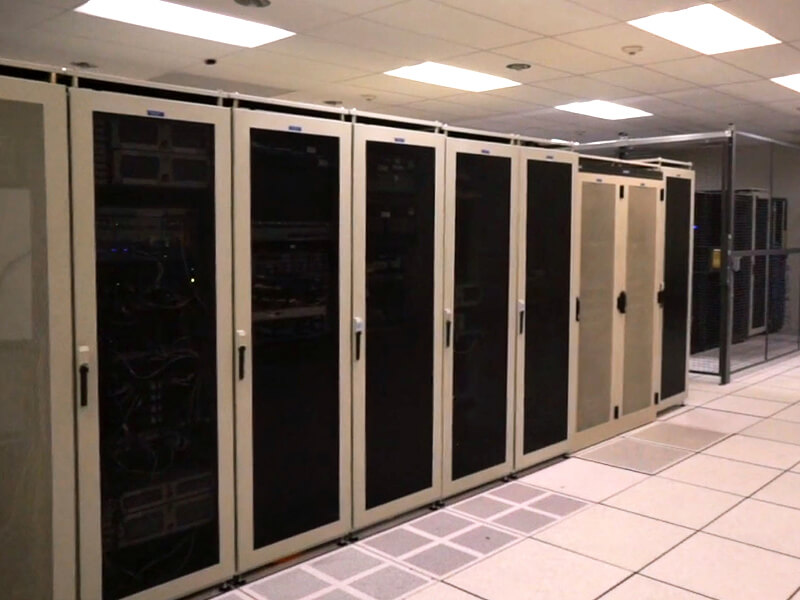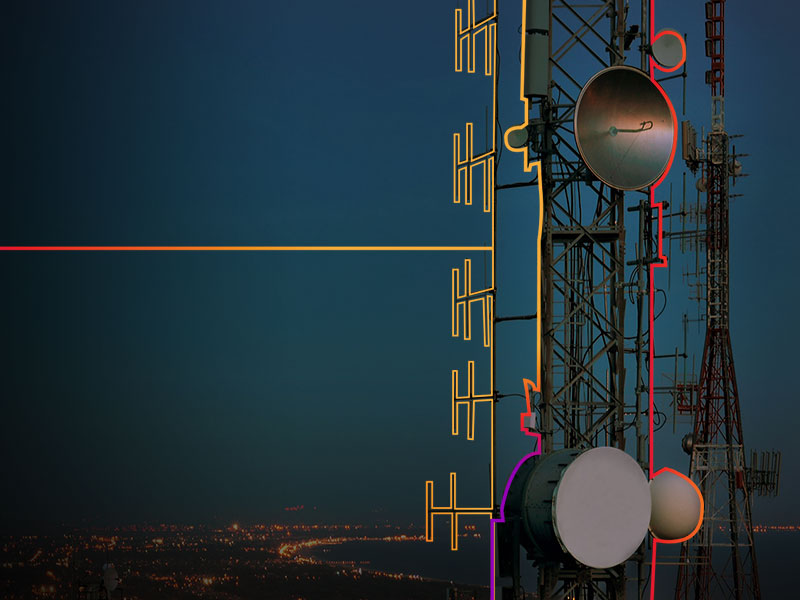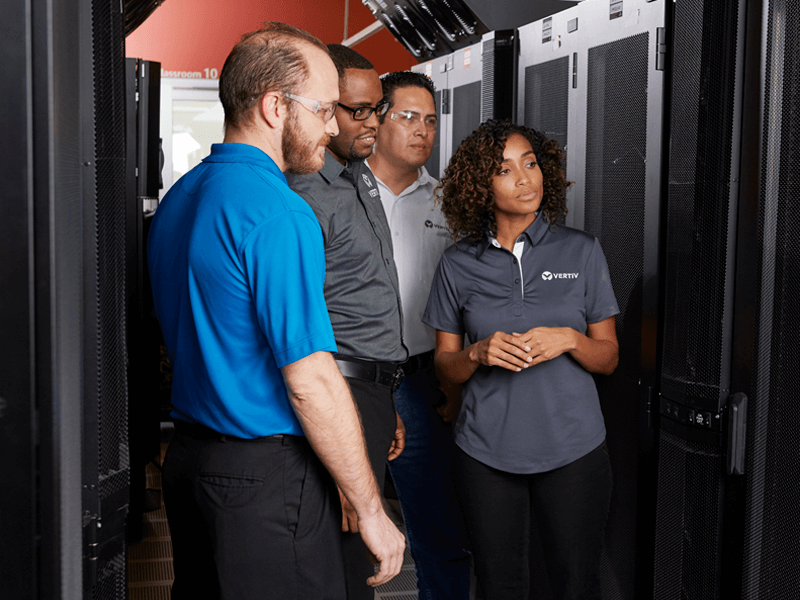
Harnessing Edge Computing
for Business Growth
What Is Edge Computing?
Edge computing is simply optimizing data processing.
The vast amounts of data created by organizations can not always wait to be processed off site by corporate networks or cloud providers. This data produced by users devices, machines, or machine-to-machine (M2M) connections, can be collected and analyzed at the edge to provide immediate insights for businesses and applications that can not afford any delays due to latency.
“Edge computing places content, data and processing closer to the applications, things, and users that consume and interact with them.”


[Edge computing] takes the classic IT workload quandary of ‘What goes where?’ and encourages workload and capability placement that optimizes the balance of latency, bandwidth, autonomy and security across a continuum of options, from hyperscale data centers to home thermostats.
- Gartner

“Global spending on edge computing will reach $250 billion in 2024.”
Participants in the Vertiv Data Center 2025 survey expect a 400% growth in their edge sites.
High-speed trading, high-definition content delivery, and autonomous cars all depend on near-real-time compute capabilities. Without them, these applications would experience detrimental performance issues, ranging from financial losses to a poor user experience, or even loss of life. Similarly, consumer-facing companies such as healthcare organizations and retailers may want to push offers or services to consumers’ mobile devices and wearables but must abide by data privacy regulations. As a consequence, these firms would prefer to process and store data at edge sites — on-premise locations that they control — rather than via the cloud to streamline regulatory compliance.
Edge computing solves for a myriad of organizational needs and application requirements, opening up a world of possibility.
Learn More about Vertiv Edge Solutions.
Benefits of Edge Computing
Data is growing exponentially, increasing in volume, variety, velocity, and variability. In addition to business data, organizations can harness online and mobile user data, social media, transactions, M2M data, log data, and other sources to acquire new insights. However, much of that data is never collected or used.
Your organization's current data use may be akin to a pastel drawing, but if you exploit big data's potential, you could create rich 3D, full-color data models. By improving your insights over time with artificial intelligence (AI) and machine learning (ML), you can identify new B2B and B2C business opportunities, deepen customer relationships, improve return on investment (ROI), and grow market share.
Industry is evolving fast, creating increased demands for data and analytics. These trends include digital transformation, hybrid work models, automation, advanced robotics, Internet of Things (IoT) applications, and augmented reality/virtual reality (AR/VR) to name just a few.

Source: Analysys Mason
5G networks are the final piece of the puzzle, providing organizations with the bandwidth and ultra-fast processing speeds they need to deliver data-intensive applications to consumers and business users in near real-time. While cloud workloads can take up to 100 milliseconds to process, edge and 5G will be able to ultimately push processing down to under one millisecond.
It will take time for 5G to reach its full potential, due to emerging standards and its slower rollout, so edge computing essentially acts as the “last mile” for processing data and keeping latency low, currently around 10 to 50 milliseconds, depending on where sites are located.
The edge, supported by 5G networks, will help organizations capture; process; and operationalize business, mobile, social, M2M, and other types of data. As a result, edge computing’s importance will grow exponentially over the coming years.
By tapping edge computing’s ability to process data workloads at the source, organizations can drive new business value. They can automate key processes, use new analytics to inform strategic decision making, customize digital products and services, and deliver an exceptional end-user experience, among other strategic goals.

Edge computing spans a wide array of industry applications, use cases, and computing infrastructures. What edge computing means to businesses may vary significantly from one to another.
Exploring the Edge Computing Ecosystem
The diversity of edge applications can create some confusion, so it can be useful to think of them first in terms of archetypes before drilling down into the use cases. Vertiv analyzed more than 100 industry use cases to develop the following four archetypes, organized by bandwidth, latency, security, and availability requirements:
- Data-intensive: the amount of data makes it impractical to transfer over the network (due to data volume, cost, or bandwidth issues)
- Human-latency sensitive: services are optimized for human consumption
- Machine-to-machine-latency sensitive: services are optimized for machine-to-machine consumption
- Life critical: use cases that directly impact human health and safety
"90% of industrial enterprises will be using edge computing by 2022."
The Edge Computing R(evolution)
Edge computing isn’t new. It began in the late 1990s, when organizations launched content delivery networks (CDNs) and peer-to-peer (P2P) networks, building on earlier file sharing efforts.
Edge computing owes its true ascent to cloud computing, spurred by Amazon Web Services (AWS), Microsoft, and others. Organizations that adopted cloud computing traded heavy upfront capital investments and fixed, hard-to-modernize technology for on-demand, pay-as-you-go, innovative services that continually evolve. With cloud computing, organizations can respond to business growth and demand spikes in real-time and reduce costs over time. While the cloud took a while to catch on, organizations are increasingly adopting cloud-first IT strategies.
Fog computing connects the edge and the cloud, or more precisely, IoT-connected devices and remote data centers. Fog computing typically consists of edge servers that are grouped together in cloudlets or micro data centers to provide local storage and processing, enhancing data collection and control. Fog computing differs from edge computing, in that fog pushes processing to local area networks, whereas edge pushes much of the processing into the devices themselves. However, because all processing is localized rather than cloud-based, some analysts see the terms “fog” and “edge” computing as interchangeable.
“Edge internet is not an extension of the cloud, or a subset of 5G. Edge internet is a fundamental transformation of how computing is done. We are moving from centralized cloud to edge-enabled or edge-led architecture, and what that means is you start to deploy nodes closer to the user and on demand.”
- Chetan Sharma, Analyst
Simultaneously, marketplace advances, related to chips, batteries, servers, precision power, and cooling technologies have enabled the development of sophisticated micro data centers and IT closets. These smaller-scale compute capabilities can be flexibly installed wherever and whenever needed.
In addition, remote monitoring and management software enables IT teams to oversee edge sites without the need to travel to off-site locations for routine maintenance or troubleshooting. IT can configure, upgrade, and maintain devices using secure connections and remote tools.
While on-premise infrastructure and cloud computing centralize workload processing, edge computing decentralizes it. By its very nature, edge networks enable certain types of applications that wouldn’t be possible otherwise.
So, should you use cloud, fog, or edge computing? The answer is probably all of the above. Edge and fog computing don’t replace cloud computing. They extend and enhance it.
Consider a wide range of business and technical requirements to select the best compute models for your business. As the graphic at the right shows, the answer isn’t always straightforward.
IT teams, strategists and innovation experts can help you understand where to place technology investments and workloads both now and in the future.
That is important, because as with other emerging technology, standards, capabilities, tools, and connections are changing rapidly. Understanding where edge computing is headed can help you design networks that are interoperable, rather than incompatible, over time.

Source: Business Insider
Types of Edge Sites
Edge technology is deployed at a wide array of sites. These sites typically follow four deployment patterns:
-
Geographically dispersed: Similarly sized sites that are spread across a country or region. Examples include retail stores and bank branches.
-
Hub and spoke: Small “spoke” sites organized around a larger “hub” site in a country or region. Examples include communications and logistics networks.
-
Locally concentrated: Local networks, with small sites connected to a larger central facility, often in a campus setting. Examples include healthcare, education, and industrial operations.
-
Self-sustained frontier: Large individual edge sites with a widespread regional or global footprint. These are often modular data centers serving sizeable areas. Examples include cloud services and natural disaster recovery operations.

Edge sites can be further analyzed by technical and environmental requirements. When categorized this way, they include:
-
Conditioned and controlled: Purpose-built spaces that are climate-controlled and secure. The only difference is per-rack density. Edge data centers fit into this category.
-
Commercial and office: Occupied spaces with existing, but limited, climate control. These sites are typically less secure. An office complex for physicians group would be in this category.
-
Harsh and rugged: Sites that require robust systems and enclosures to protect against air pollution. They are often industrial sites that may be threatened by water exposure and are close to heavy traffic or machinery. They lack climate control and are far less secure. A water treatment plant at a university would be a harsh and rugged site.
-
Outdoor standalone: These unmanned sites are exposed to outside elements and require a shelter or enclosure. They may be in remote locations that are harder to reach for servicing. Cell towers are a perfect example of this category.
Understanding Edge Architecture
As you design your edge architecture, likely starting with the desired power architecture, you will need to work through a variety of other considerations, including:
Latency needs: While many business applications can tolerate latency of 100 milliseconds or more, others can’t. This will affect what type of edge site you build and where you place it.
Environmental conditions: If an edge site is in a business facility, rather than a fit-for-purpose data center, you’ll need to consider such issues as heat, moisture, airflow, security, and more.
Space: While many industries own space where they can deploy edge sites, others may not. For example, telecommunication companies lease, rather than own, cell towers.
Scale: Is your organization deploying one edge site or thousands? This will affect the network architecture model, technology, and monitoring and management processes you use.
Automation: Consider automation to simplify routine processes such as device configuration and updating at multiple off-site edge locations.
Single pane of glass: A centralized dashboard will make it easier to oversee edge operations, especially as they grow.
Remote management: The ability to remotely monitor and manage devices streamlines day-to-day IT responsibilities. With out-of-band management capabilities, IT teams can access edge devices directly in the event of a network outage.
Resiliency: Like other IT networks, edge sites should be built for resiliency. For example, uninterruptible power supplies (UPS) provide backup power to continue operations in the event of a power failure.

Source: Analysys Mason
Scaling With 5G
Telecommunications providers are rolling out 5G networks around the globe. These new cellular telecommunications networks provide exponentially more bandwidth and faster processing speeds than today’s 4G networks. They also enable multi-access edge computing (MEC), sometimes called mobile edge computing, which pushes application execution and other processing tasks closer to the user, enhancing performance.
These innovations will enable organizations to tap the power of mobile data, to create a fuller picture of user behavior and needs. They will also power data- and analytics-intensive applications such as advanced robotics, smart applications (cities, factories, security, transportation, wearables), VR/AR and more.
"5G networks will increase speeds by 10X over 4G networks."

By 2024, more than 40% of the world’s population is expected to have access to 5G networks. As a consequence, organizations are preparing now for the coming gold rush of new business opportunities. Those firms that can exploit 5G-enabled use cases first will likely seize outsized market share.

Source: State of the Edge/Venture Beat
Edge Opportunities and Goals
Industry organizations are moving fast to capitalize on the wealth of new data that’s being created. Edge computing can help you fuel business growth, reduce latency, extend your hybrid cloud infrastructure, and capitalize on the power of artificial intelligence (AI) and machine learning (ML).
You also likely have goals for your edge sites, including deploying, upgrading, expanding, and managing and monitoring these compute resources. As with all technology, it pays to understand your full range of options, adopt standards-based solutions wherever possible, and take a lifecycle approach to investment and management.

Edge Growth Opportunities
The pandemic accelerated spending on edge computing, as companies invested in digital products and services. Now, it’s off to the races. So, where will we see the most edge growth moving forward?
Hardware, software and services: IDC projects that spending on edge compute and storage will soar to $33.3 billion by 2024, as organizations build out their infrastructure. Business will also invest in remote monitoring and partner services to manage edge sites.
Regional adoption: It’s no surprise that Asia-Pacific is leading edge adoption, given that region’s heavy investment in automation, robotics, and smart applications. Asia-Pacific will have 37.7% of the world’s infrastructure edge footprint by 2028. Following fast behind is Europe with 29% of the world’s footprint. The United States will represent 20.5%, Latin America 7%, and Africa and the Middle East 5.8%, according to a report from The Linux Foundation.
B2C versus B2B applications: Some 36.5% of the global infrastructure edge footprint will be focused on mobile and residential consumers, while 11.9% will be directed to enterprise IT uses. Communication service providers (CSPs), also known as telcos, will represent another 10.4% of the world’s footprint.
Cloud: Cloud growth has soared during the pandemic. Some 86% of IT decision makers believe a hybrid cloud infrastructure is the ideal model, and 46% accelerated investments during 2020, according to a Nutanix study. However, edge growth is coming on so strong, that cloud providers are offering edge capabilities, rightly seeing edge as a competitive offering that could eat into their market share.
IoT: With 5G and edge growth, IoT will take a giant leap forward. Many organizations have devices that can be connected to gain new insights but have lacked the data integration capabilities, processing power, and budget to make this happen. Edge solves for these issues. In the B2C realm, consumers are becoming more comfortable with connected experiences and are willing to give up their data to enjoy personalized services. As a result, both B2B and B2C IoT applications will flourish.

Source: The Linux Foundation
Latency: Consumers are increasingly unwilling to wait. eCommerce studies have documented that even a 0.1 second improvement increases page engagement and sales. Similarly, for life-critical or business-critical applications such as trading, latency means it’s game over. The race to under one millisecond will characterize the next few years, with winners and losers. Eventually, near-zero latency will become the industry standard.
Analytics and automation: Analytics, automation, and process optimization powered by AI and ML rely on the ability to perform near real-time processing of vast data sets. Edge computing makes this possible by eliminating the need to transfer workloads to the cloud and enabling almost-instant decision making. In addition, edge computing enables organizations to perform analytics on sensitive data, such as consumer transactions, or health or tax data, while protecting data privacy.
How Latency Harms the User Experience
|
Time to load (milliseconds) |
User impact |
|---|---|
|
0 to 16 |
Users are exceptionally good at tracking motion, and they dislike it when animations aren’t smooth. They perceive animations as smooth so long as 60 new frames are rendered every second. That’s 16 milliseconds per frame, including the time it takes for the browser to paint the new frame to the screen, leaving an app about 10 milliseconds to produce a frame. |
|
0 to 100 |
Respond to user actions within this time window and users feel like the result is immediate. Any longer, and the connection between action and reaction is broken. |
|
100 to 300 |
Users experience a slight perceptible delay. |
|
300 to 1,000 |
Within this window, things feel part of a natural and continuous progression of tasks. For most users on the web, loading pages or changing views represents a task. |
|
1,000 or more |
Beyond 1,000 milliseconds (1 second), users lose focus on the task they are performing. |
|
10,000 or more |
Beyond 10,000 milliseconds (10 seconds), users are frustrated and are likely to abandon tasks. They may or may not come back later. |
Source: Deloitte
Edge opportunities are seemingly boundless, which will drive significant investment in this sphere. Organizations don’t want to be left behind in the race to drive more revenue from the data they already possess.
How Edge Enables IoT
5G and edge computing will unlock the potential of IoT, providing the bandwidth, low latency, and local processing capabilities required to deliver B2B and B2C applications.
It is important because companies are connecting more devices than ever in an effort to gain more insight, enable automation, and create connected systems of intelligence.
" 43 billion – The number of IoT devices there will be by 2023."
Consumers have already seen the impact of IoT with smart home systems, including security, health and fitness wearables, mobile marketing in stores, and retail self-checkout, among other end uses.

Source: Vertiv Data Center 2025 Report

Source: Ez En Route
IoT will have the biggest impact in the world of business and government. IoT has already been operationalized by manufacturing companies to enable automated processes, robotics, and preventive and predictive maintenance. With millions of dollars invested in equipment, IoT can help organizations avoid costly breakdowns or unexpected outages.
IoT sensors collect a wealth of information about the devices to which they’re connected, including their airflow, temperature, humidity, chemical composition, level, moisture, motion, velocity, proximity to other devices, water quality, and the list goes on and on. As a result, IoT sensors can create an accurate picture of device performance and surrounding conditions.
Sensors, pervasive connectivity, and lightning-fast processing will enable smart transportation with synchronized lighting, traffic management, and tolls. Smart buildings will improve user comfort and help workers manage and optimize spaces. With smart cities, systems of intelligence will streamline how residents work, play and travel. Autonomous cars will make routine commutes safer and more enjoyable. It’s clear that the world will look radically different in just a few short decades as IoT applications become more sophisticated and interoperable.
Product teams can use VR/AR to develop and test new products, collaborating and easily incorporating consumer feedback. Frontline workers in healthcare, manufacturing, and other industries can use VR/AR to access the remote expertise they need to do their jobs.
IoT devices have sensors that transmit continuous information about their health, performance and status. That data is aggregated and processed, either via cloud or edge computing. When processed at the edge, connected systems can leverage intelligence in near real-time. They also can capitalize on virtuous feedback loops, improving processes over time.
“IoT will have a potential economic impact of between $4 trillion and $11 trillion by 2025.”
How do organizations use edge networks to enable IoT applications?
IoT Applications
- Uses smart devices: Sensors collect multiple data points about a device conditions for use with IoT applications.
- Implements an IoT gateway: The gateway helps route workloads appropriately, keeping data at the edge or sending to the cloud or corporate data center for processing.
- Relies on robust connectivity: High-speed connectivity ensures seamless data transfer with minimal latency.
Edge Computing
- Uses complex event processing (CEP): CEP systems integrate data, look for patterns, and then take automated actions. These open-source systems run both in the cloud and in edge devices.
- Harnesses ML and AI: Your IT team can use existing algorithms or build their own, all with the goal of improving their ability to identify certain conditions and then automate key actions. These capabilities are increasingly being performed in edge devices, rather than just the cloud.
- Powers IoT edge applications: Vendors are bundling core capabilities, such as CEP, AI, and other tools into devices, speeding deployment, upgrades, and changes.
- Offers offline data storage: With local storage, devices can continue operating in the event of network disruption.
- Provides robust data management capabilities: Intelligent capabilities determine which data to collect and process and at which time intervals.
Resources
Edge IT Goals
The fast pace of digitization has spurred edge computing growth. As a consequence, IT teams are refining technology strategies to align compute models against business and technical objectives. Here are some common goals you may have for your edge deployments.
Deploying Edge Infrastructure
You want to evolve your hybrid/cloud infrastructure to enable new edge applications. These goals include:
1. Rationalizing workloads: Deciding where to run key workloads based on latency, cost, security, data privacy, or other issues.
Approach: An IT partner can support, identifying unique needs based on the application and developing an overall edge strategy.
2. Creating application profiles: Developing a standard edge infrastructure for different application types brings consistency to deployments and ensures they perform as expected.
Approach: Developing standardized documentation, including specifications, will be key to scaling your edge presence.
Upgrading Edge Infrastructure
You want to support new applications and more data, which requires upgrading your existing edge technology. Your goals include:
3. Ensuring high reliability of your infrastructure: Distributed networks help support your growing business. Maintaining high uptime and throughput of all edge sites is a priority.
Approach: Evaluate line-interactive versus double-conversion UPS topologies, enable connectivity for remote monitoring, and ensure there are adequate resources available for UPS service.
4. Simplifying edge infrastructure: Growth is easier with standardized processes and technology. They help speed ordering, deployment and management.
Approach: Consider standardizing infrastructure wherever possible and ordering equipment that offers built-in flexibility for business growth or adaptability.
5. Quickly implementing new infrastructure to support edge sites refreshes: Advanced technology for data-intensive applications require edge capabilities that keep pace. That means refreshing both IT equipment and the supporting infrastructure that protects it.
Approach: Determine the feasibility of using factory integration services to receive IT-ready infrastructure. Finally, you’ll want to determine the availability and skill level of staff or partners to install edge technology.
Expanding Edge Infrastructure
You may want to put IT in new locations, where it’s never been before. That means designing the right compute, storage, and networking footprint, as well as selecting the racks, power, and cooling equipment that supports it. Your goals include:
6. Gaining more capacity: Increasing the output at existing sites to support business growth.
Approach: Size UPS units to meet evolving requirements, evaluate heat loads to determine the need for dedicated cooling, and enable connectivity for remote monitoring.
Monitoring and Managing Edge Sites
You’d like to centralize your visibility into – and control over – your edge sites. You want to ensure equipment uptime and availability, while also securing equipment from unauthorized access.
7. Managing a growing edge network: A scalable approach for managing IT equipment will minimize growing pains, while keeping performance high.
Approach: Identify everything that requires monitoring, ensure that power and thermal management infrastructure is equipped for connectivity, and determine that individuals are available to monitor and respond to alerts.
8. Enabling remote management: Closely monitoring the condition of IT equipment will increase its availability, utilization and efficiency.
Approach: Remote monitoring and management software and tools help enable authorized users, limit or lock down operations that can be performed, and monitor environmental conditions and device performance.
9. Managing edge site temperatures: IT equipment increases temperatures, especially in small spaces such as IT closets. If not corrected, excessive heat can harm devices.
Approach: Evaluate the heat load of technology which can determine if you need dedicated cooling. Remote environmental monitoring can help IT identify hotspots and resolve them proactively.
10. Scaling your IT team’s talent: It may not always be practical or desirable for IT teams to visit edge sites.
Approach: Utilize remote monitoring and management software for routine configuration, upgrades, and troubleshooting. Consider engaging a local partner to install new technology and service critical infrastructure such as batteries when needed.

Edge Solutions
IT teams typically want to source and deploy edge solutions in days or weeks. Containerized solutions, such as integrated infrastructure, micro data centers, and prefabricated modular data centers provide powerful compute and other capabilities, while offering speed to market and physical security.
Edge IT solutions integrate cooling and climatic controls, power distribution, and network connectivity. They also may include equipment for physical security, fire suppression, shock absorption, electromagnetic interference protection, power conditioning, as well as UPS or batteries. IT teams typically also opt for remote monitoring and management software and devices to help ensure edge solutions perform as expected.


This equipment enables users to create a data center in any space available. For example, schools can deploy modular units at edge sites or on campus. Even a hallway will do.
Integrated infrastructure is pre-validated and ready to deploy in days, so there’s no need to design solutions or integrate components. They are secure, all-in-one units that have a compact design and integrated fire suppression systems, making them ideal and safe for a wide range of spaces.

Micro data centers offer powerful computing capacity in a small physical footprint. For example, a healthcare facility or hospital might deploy a micro data center to power telehealth applications.
These all-in-one solutions combine power, cooling, monitoring, and racks and can be deployed inside or outside a building – or even serve as one.

Prefabricated Modular Data Centers
When more compute or flexibility is needed, IT can deploy a prefabricated modular data center that is easily assembled on site. With powerful compute, these data centers can be used to enable any business-critical process. Examples include data centers for critical government infrastructure used for border, energy, and water management.
These solutions are pre-engineered, assembled, integrated, and tested, meaning they’re low-risk and fast to implement.
Other Edge Computing Considerations
You’re on your way to designing and developing your edge infrastructure. You understand your application needs and types of sites, and the technology you’ll be deploying.
You can use reference designs to speed technology deployment. Before you choose your infrastructure, there are some other key issues you should consider, including edge site processing efficiency, sustainability, energy consumption, and hidden costs to operate. Let’s take a look.
Designing Edge Infrastructure
Designing the infrastructure for an edge application can seem daunting. Compute needs, physical environment, power and thermal management requirements, physical security, and remote monitoring and management capabilities must all be considered. Then, there is the tricky issue of future-proofing technology. Edge standards and devices are changing rapidly. Making the wrong decision could mean that you could need to re-invest in IT sooner than expected if you don’t design for growth and scalability.
In addition, if you don’t have an IT team at the ready, you may need to navigate research and purchasing decisions yourself.
Fortunately, vendors are simplifying and standardizing the buying process. They may offer reference designs, which provide recommended solutions to accomplish specific goals. They typically provide racks with integrated cooling, intelligent power distribution, and backup power supplies. Other components will vary, based on the application requirements. They also can be customized with additional devices and services.
Reference designs provide an all-in-one expertly crafted solution to address common challenges in various environments. Each design can be tailored to individual needs to meet unique business needs. Installation and maintenance services are also available to streamline deployment and to provide peace of mind over the life of the products.
Reference designs provide fast access to edge computing, so that an IT partner can minimize deployment time, protect critical infrastructure, and connect to remote IT monitoring.

Edge Efficiency and Sustainability
As the world grapples with the impacts of climate change, edge computing can guide the way to more efficient, sustainable processes. Although there are some gains to be achieved with processing, the edge’s greatest contribution will be in providing insights that help industry optimize processes at scale.
Cloud computing is already is far more efficient than most people know thanks to technology advances, including the development of hyperscale computing and optimized power and thermal management systems.
From 2010 to 2018, the demand for data center computing (cloud and on-premise) was five times the expected growth. And by 2018, 89% of all compute instances were hosted by cloud data centers. Despite this torrid growth, the world’s data centers only consumed 205 terawatt-hours of electricity, or just 1% of the world’s electricity in 2018, according to Data Center Knowledge.

Source: BusinessWire/Vertiv
But edge can push those gains further and faster. Consider these benefits:
Edge Computing Increases Efficiency
- Data is processed and stored at the source: This eliminates the need to transfer data to the cloud, making processing more efficient and reducing energy consumption.
- Edge can be used to extend or replace IT infrastructure: Organizations now have a choice as to whether to contract their computing needs to off-site cloud vendors or to deploy IT infrastructure within their edge sites. As a result, they gain flexibility and can align workloads to meet key goals and requirements.
- Edge sites can be managed remotely: Powerful remote monitoring and management capabilities enable IT teams to configure, update and troubleshoot devices. With out-of-band management capabilities, they can perform these functions even when corporate networks are down.
- Liquid cooling gives edge operators more options: Edge computing often enables high-performance workloads such as data analytics and ML. This increases the number of racks required, causing temperatures to exceed the cooling capabilities of traditional air-cooled solutions. Liquid cooling can effectively maintain temperatures, even in edge sites that lack water supplies.
Edge Computing Increases Sustainability
- Edge sites use hardware that’s already available: Hyperscale computing centers thrive on using the most advanced technology. Edge computing often utilizes mainstream technology, including servers, smartphones, operational technology such as production equipment, desktop computers, and internet gateways. It’s likely you already have some of the components you need to get started with edge.
- Edge applications provide powerful insights: IoT/edge applications water leaks, unoptimized processes, and other issues that could save billions of dollars and reduce carbon emissions. For example, U.S. commercial buildings waste 30% of the energy they use, according to the U.S. Department of Energy. So reducing that waste with IoT and edge computing can contribute to a greener planet.
- Edge computing enables systems of intelligence: Edge computing enables large-scale applications such as supply chain and grid optimization or energy demand management, which can provide organizations with tools to streamline processes and minimize energy consumption, even from renewable energy sources. That’s important because many organizations have committed to being carbon-neutral in the coming years.
- Purpose-built infrastructure can optimize power and cooling: Infrastructure companies have developed all-in-one systems, such as integrated rack solutions and modular data centers, to reduce power consumption and improve cooling efficiency. That means your technology wastes less energy, while still remaining protected from heat, moisture, and other environmental conditions.
Managing Energy Costs
As telecommunications companies deploy 5G networks, they will be rolling out millions of servers in smaller edge data centers. As a result, they need to address energy efficiency at scale. Telco energy costs already account for 5-7% of their operating costs, finds STL Partners. Now, 5G will increase those costs.
According to STL, telcos can drive energy efficiency by implementing the following best practices:
- Implementing advanced network technology: Deploying hardware and software designed and operated for efficiency.
- Extending the edge: Implementing new edge data centers to support cloud-native IT.
- Optimizing infrastructure management: Measuring, monitoring, managing, improving, and automating key processes.
- Enhancing investment processes: Taking a holistic, lifecycle view of costs and investments.
- Working with others: Adopting innovative commercial models and standards through collaboration.
- Empowering customers: Leading by example, telcos can demonstrate how customers can develop 5G-enabled services to reduce carbon emissions.
- Setting good governance: Telcos can use public commitments, strategic partnerships, effective policies, incentives, workforce targets, and key performance indicators (KPIs) to drive change.

Source: PWC
Always-On Computing
Edge sites often power critical services, such as high-definition content, data-intensive analytics, and healthcare and manufacturing processes. They also provide much needed workload processing capacity that extends on-premise and cloud capabilities.
It’s critical that edge sites are able to operate continuously. However, just like data centers, edge sites can be vulnerable to unplanned downtime events, caused by cyberattacks, IT equipment failures, human error, or UPS equipment or battery failure.
Edge data sites across all regions experienced an average of 5.39 unplanned outages over a 24-month period because of these reasons. These outages lasted an average of 45.4 minutes, according to Ponemon Institute.
Cost constraints can also contribute to outages if equipment is not monitored and serviced proactively. However, servicing costs typically are a fraction of potential revenue loss if edge sites power vital B2B and B2C services.
Fortunately, IT can use a number of best practices to reduce the possibility of a disabling outage. Those steps are depicted in the graphic at the right.
Hidden Costs of Edge Computing
Edge sites need backup power. Investing in the right UPS will help ensure the reliability and high availability of applications. There are some hidden costs of managing UPS infrastructure to be considered:
- Deploying, installing, and starting up UPS systems: Initial costs include UPS and battery purchases. However, installation will include labor costs, as partners deploy and configure UPS and launch and test accessories.
Buying back-up power systems that are installation-ready can help reduce labor costs. In addition, you may want to partner with a supplier that offers lifecycle support for UPS and power distribution assets, including software and hardware support. - Disposing of batteries and equipment: Battery life and capacity will degrade over time. You’ll need to remove, replace, and properly dispose of them. There are regulatory, legal, and financial issues to consider. Disposing of even the smallest single UPS can cost in excess of $100.
Options include partnering with certified recyclers who can demonstrate compliance or ensuring a new UPS provider offers these services. - Failing to properly size your UPS: Carefully calculating each UPS system’s true capacity is key to optimizing operations. Consider the power factor to confirm the load the UPS can bear.
Proper sizing will help reduce inefficiencies and ensure that the edge site doesn’t experience unintended latency. In addition, a true on-line UPS that delivers continuous, high quality AC power with no break when transferring to battery will help protect IT equipment.
- Performing ongoing monitoring and management: Proactive monitoring is a must protecting valuable IT equipment. Intelligent control systems provide proactive alerts and insights, so that IT can address emerging issues before they cause costly disruptions.
Investing in a UPS that is ready for network communications, environmental site monitoring, and data center infrastructure management will help drive performance, leading to long-term savings. - Gaining service and support: When an emergency occurs, you’ll need rapid response to prevent or limit costly downtime. However, service agreements can include hidden costs. Review agreements to understand which parts and labor are considered standard and what on-site emergency support costs.
A partner who provides 24x7x365 support will provide coverage when and where you need it. A service agreement that covers 100% of labor, travel, and parts will help protect edge assets and investments, ensuring they perform as expected.
Edge Computing Across Industries
With its wealth of applications, edge computing has something for every organization. What edge means to an organization will obviously vary based on its industry, business model, goals, and technology requirements, among other variables.
Here’s how edge computing is disrupting such industries as education, healthcare, government, and retail.

Edge Computing in Education
Educational institutions are using more technology than ever. That trend accelerated during the pandemic as they enabled widespread remote learning for students. While colleges, universities, and research centers may operate their own data centers, K-12 schools may not.
Edge computing supports remote and mobile learning, as well as new innovations such as VR/AR and makerspace, allowing educators to create interactive, personal experiences that promote learning.
Educational institutions can easily build or extend their edge presence by deploying IT infrastructure. Reference designs can help guide the selection of the equipment needed to deploy critical gear to get up and running as quickly and seamlessly as possible. They can set up network and server closets or self-contained, secure smart racks to gain capabilities in a small footprint. Or IT teams can rapidly deploy modular data centers on campuses to support e-learning at scale. All of these solutions provide reliable performance and integrated power and cooling. In addition, they can be placed in spaces that aren’t typically designed for IT.
Learn more at the education industry page.
Edge Computing in Healthcare
Healthcare organizations, including hospitals, clinics, physician networks, insurers, government entities, and more are focused on driving patient outcomes. These organizations want to deliver better service that increases patient well-being and lowers re-admittances, while driving down costs.
Simultaneously, technology is revolutionizing care delivery. Healthcare organizations are implementing telehealth applications, wearables, sensor-tagged medication, and other tools to improve patient care and compliance, while involving individuals more fully in their health journey. However, these critical services rely on continuous connectivity and high uptime to achieve their promise.
Edge computing and IoT power these new applications and deliver required performance. Edge also keeps data storage and processing local, easing compliance with the Health Insurance Portability and Accountability Act (HIPAA) in the U.S. and similar regulations overseas. In addition, edge analytics can create population data that helps providers align resources and investments with new trends.
Healthcare organizations can use reference designs to efficiently deploy server and network closets or modular data centers at the point of need. They also can use smart racks, placing secure, self-contained units in non-traditional spaces such as hospital hallways.
Learn more at the healthcare industry page.
Resources
Edge Computing in Government
Government agencies are seeking to modernize and service their IT infrastructures. During the pandemic, they faced unparalleled demand for services that strained corporate networks. At the same time, many IT and business staff were working remotely and needed secure remote access to on-premise applications and systems.
Government agencies face more stringent requirements than many other businesses and must navigate complex buying processes. Part of the nation’s critical infrastructure, continuous uptime is a necessity, as is system and data security due to confidential operations. Government budgets are often changing. What’s available one year may be eliminated the next. As a result, agencies need to move swiftly to obtain the solutions they need while navigating complex budgeting processes.
Edge computing can help government workers access the systems they need. IT workers can use remote monitoring and management to help ensure high uptime of edge sites.
Vendors can provide edge solutions that are compliant for the public sector, meeting federal government regulations, and helping agencies achieve the U.S. Data Center Optimization Initiative (DCOI) and modernization objectives.
Learn more at the government industry page.
Resources
Edge Computing in Retail
Retailers want to deliver on the promise of omnichannel commerce. Physical stores represent an asset that can be exploited more fully with technology, converting product interactions into a true exploration and research experience. Shoppers are researching and buying via mobile devices, websites, and stores and expect a seamless journey. Some key trends that have challenged retailer processes and systems include shoppers’ embrace of reserve online, pickup in-store (ROPIS); buy online, pickup in-store (BOPIS); and buy online, return in-store (BORIS) behaviors.
In addition, advanced analytics can help retailers improve everything from just-in-time manufacturing processes to distribution and inventory management. As stores increasingly serve as distribution centers, retailers know it’s important to get online fulfillment right to guarantee customer satisfaction and maximize profitability.
Edge computing helps retailers meet these demands. Edge technology, such as smart cabinets, can be flexibly placed in stores to power new applications, while modular data centers in warehouses can enable sophisticated analytics that optimize every aspect of supply chain processes. Retailers can select their own solutions or use reference designs to align technology to their physical space, security needs and on-site environmental conditions.
Resources
Seize the Future with Edge
Whether you’re just getting started or rapidly scaling your network, edge computing can help you deliver an exceptional experience with minimal latency. You can also tap the power of automation and analytics to transform your business, identifying and eliminating process inefficiencies.
Edge computing helps solve the challenge of where to process data-intensive workloads, reducing bandwidth and network strain while reducing costs. Infinitely scalable and able to be deployed when and where you want, edge brings data center capabilities to you. As a result, edge levels the playing field between organizations, providing compute capabilities within reach.
Finally, edge computing enhances your organization’s business continuity and disaster recovery strategy, security posture, and ability to meet compliance obligations by enabling a distributed network that offers local data storage and processing.























































































